Altan T. Metal Forming Handbook
Подождите немного. Документ загружается.

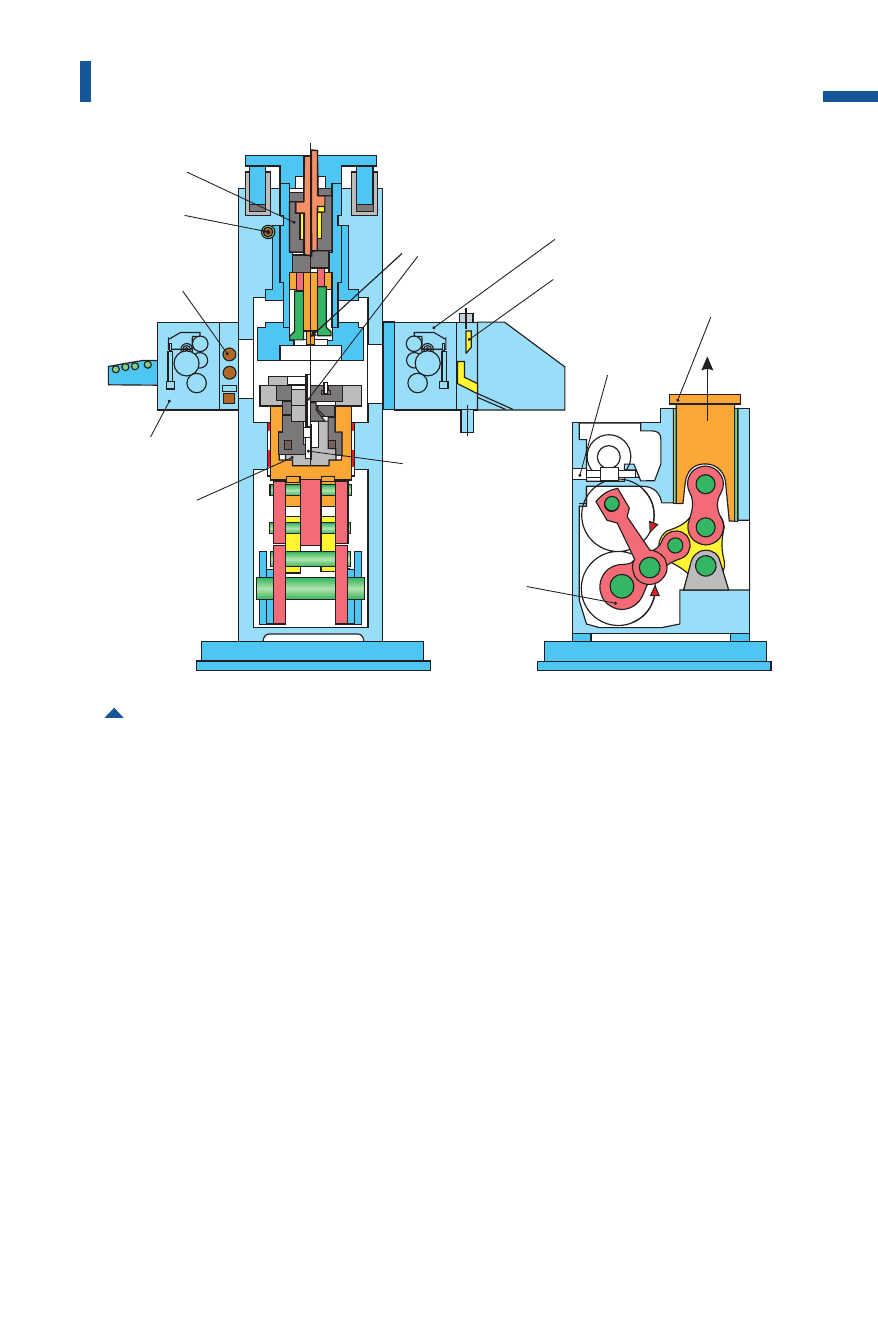
The gib geometry comprises a high-precision eight-track sliding gib.
This construction is able to largely eliminate slide tilting even under
major eccentric loads.
Efficient hydraulic fine blanking presses with a total force ranging
between 2,500 and 14,000 kN are equipped with a pressure accumulator
drive. The counterpressure piston is integrated in the slide, and the vee-
ring piston is mounted in the press crown. Both pistons are equipped
with support bolts, in order to provide support over the entire surface of
the dies. Hydraulic fine blanking presses are characterized by:
–application of force independent of slide position,
–processing of material thicknesses up to 12mm,
–integration of forming operations into compound progressive and
transfer dies,
–a high degree of operational reliability in the work process.
361
Fine blanking
Fig. 4.7.27 Layout of a mechanical fine blanking press
vee-ring
piston
dieheight
adjustment
lubricationsystem
infeedroll
counterforce
piston
centralsupport
punchtightening
rod(formoving
punchsystem)
double
knuckle-
joint
wormgear
drive
slide
outfeedrollwithscrap
webshear
croppingshear
Metal Forming Handbook / Schuler (c) Springer-Verlag Berlin Heidelberg 1998
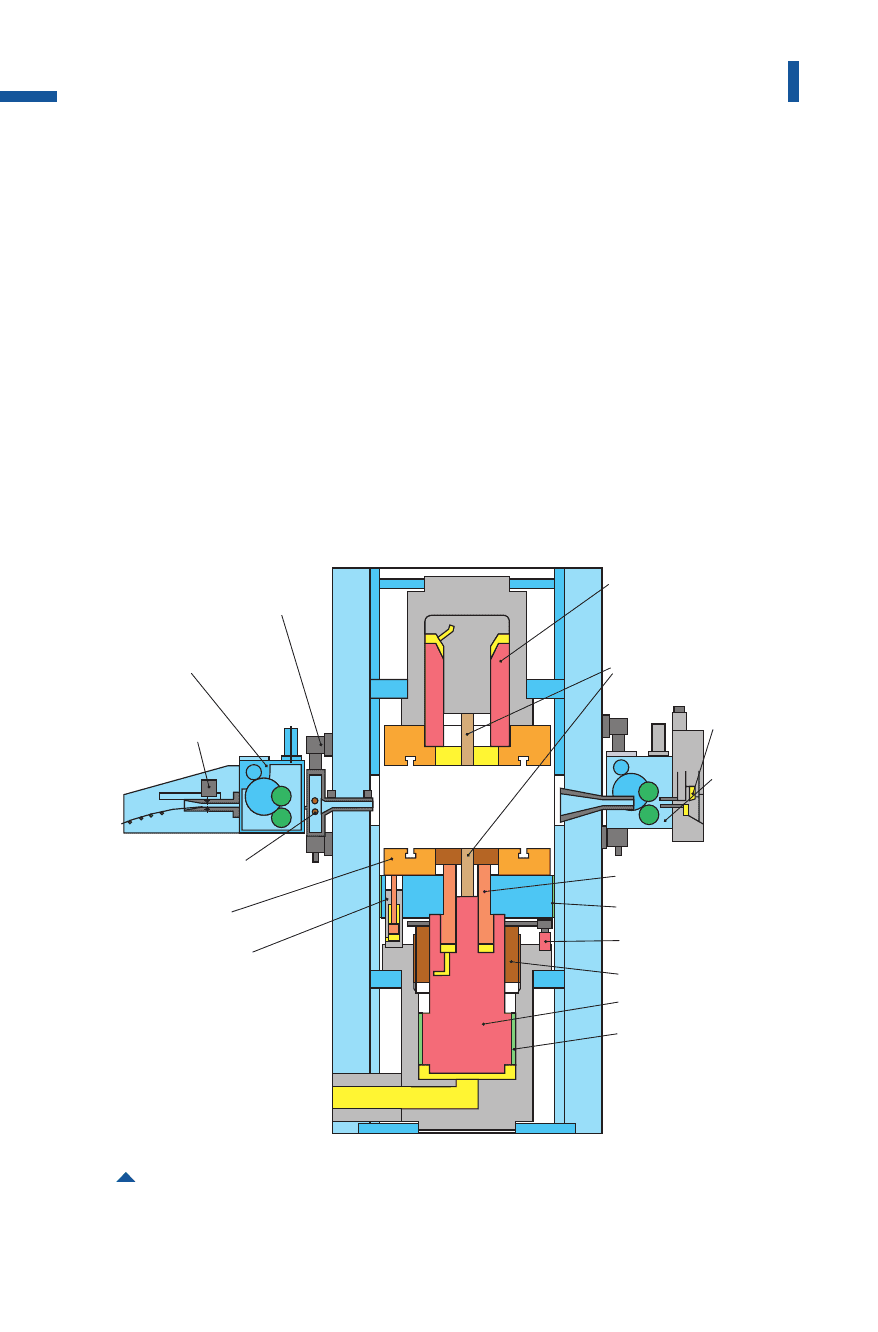
Due to the design principle of the fine blanking dies, not only the blank
itself but also all trimmings and inner form slugs are ejected or stripped
of the die into the die area. The workpieces and scrap are then removed
from the die mounting area by means of air jets or removal arms. If
there are parts still remaining in the die area before the next blanking
cycle, the slide movement must be halted in time to avoid damage to
the die. For this purpose, fine blanking presses are equipped with tool
breakage safety systems.Systems used include die stroke-dependent sen-
sors, die-independent sensors in mechanical presses and die-indepen-
dent pressure sensing in hydraulic presses.
Die-independent pressure sensing offers the greatest degree of safety,
but can only be used in hydraulic presses (Fig.4.7.29).The system works
362
Sheet metal forming and blanking
Fig. 4.7.28Layout of a hydraulic fine blanking press
vee-ringpiston
diechange
clampingtable
centralsupport
cropping
shear
outfeed
roll
counterforcepiston
slidegib
actuatingmotor
fixedstop
mainworkingpiston
slidegib
feedheightadjustment
infeedroll
infeedrollbasket
lubricationsystem
rapidtraverseclosingpiston
Metal Forming Handbook / Schuler (c) Springer-Verlag Berlin Heidelberg 1998
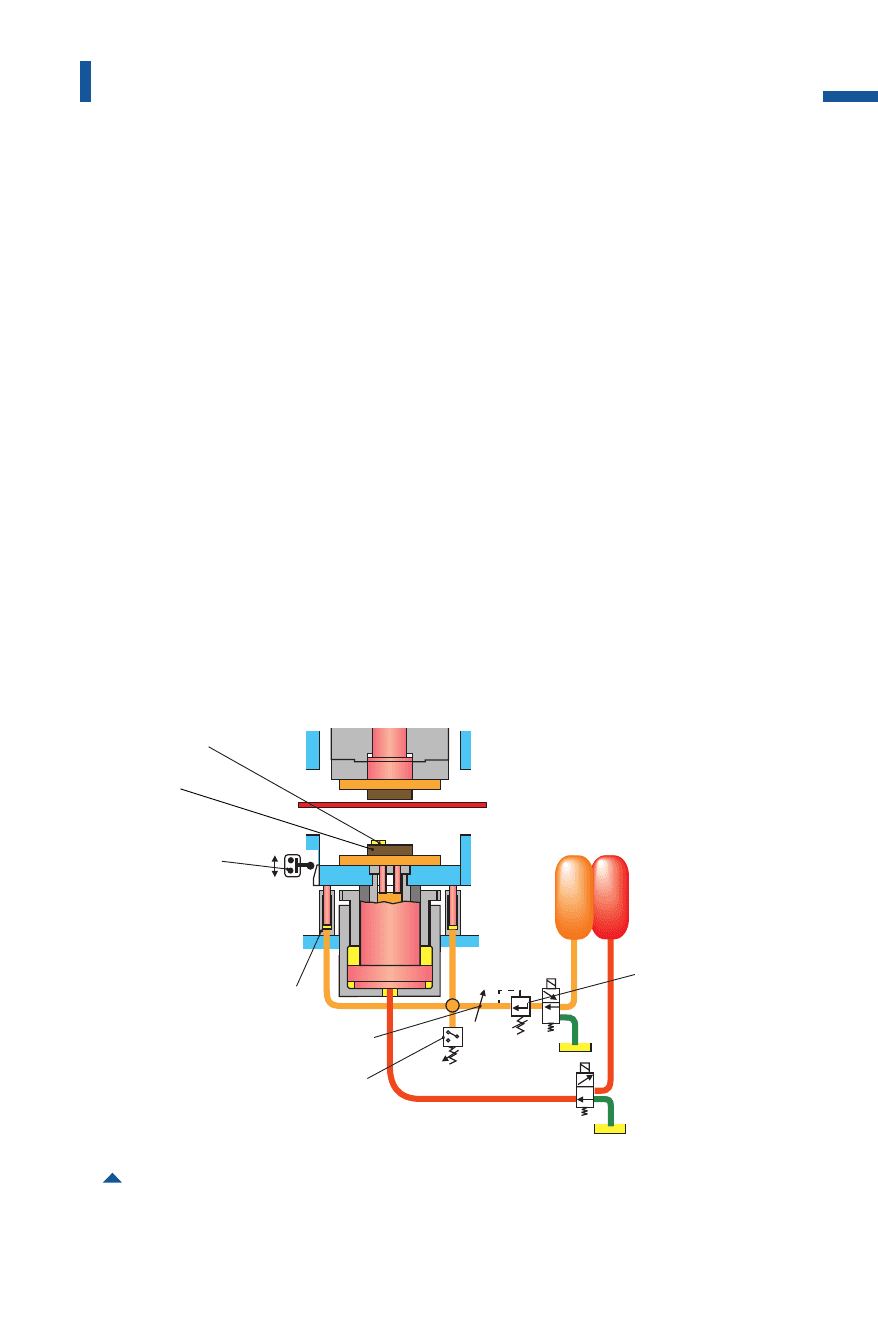
measuring the pressure in the rapid traverse closing cylinders. Pressure is
applied to the rapid traverse closing cylinders from the low pressure
system in such a way that the weight of the slide and the bottom die
can just be raised at tracing speed (Fig.4.7.4).If the operation is unin-
terrupted, the slide switch activates the high-pressure accumulator, and
the main piston initiates the blanking movement.
If there are foreign objects located in the die, the contact between the
foreign object and sheet metal or upper die initiates an increase of pres-
sure in the rapid traverse closing cylinder before the slide switch is
reached. The pressure increase – a maximum of 2 bar – is detected by a
pressure switch, causing the press control system to interrupt the clos-
ing movement immediately. This safety system offers the following
advantages over other systems:
–structurally cost-effective solution,
–monitoring of the entire die space,
–no moving parts in the die space,
–tracing speed and pressure can be set depending on part sensitivity.
363
Fine blanking
Fig. 4.7.29 Die-independent pressure tracing
HD
)(
ND
foreign object
bottom die
slide switch resp.
position encoder in
numerically controlled
presses
pressure switch
tracing speed controller
tracing pressure
controller
rapid traverse closing piston
Metal Forming Handbook / Schuler (c) Springer-Verlag Berlin Heidelberg 1998
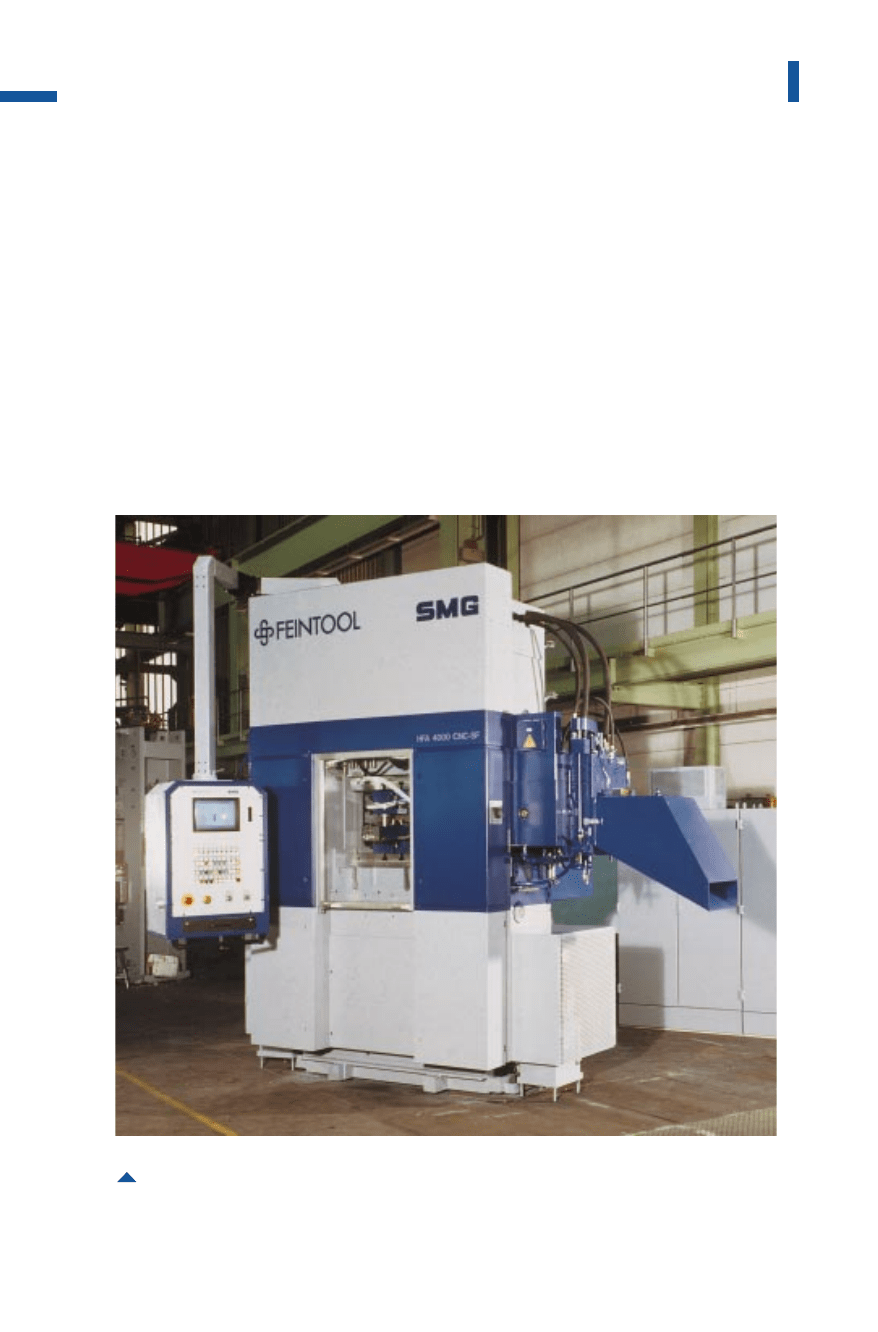
Examples of production lines
Figure 4.7.30shows a CNC-controlled hydraulic fine blanking press with
a total press force of 4,000 kN. Its maximum part-dependent stroking
rate is 50/min.
Figure 4.7.31illustrates an automatic production line for the manu-
facture of synchronous tapered plates in three stages. The nerve center
of the line, which produces some 4,500 parts per shift, is a CNC-con-
trolled hydraulic fine blanking press with a total force of 14,000 kN.
The complete line can be operated by a single person.
The blanks produced on a blanking press are stacked on pallets and
then deposited on the height-adjustable pallet platform. From here, the
364
Sheet metal forming and blanking
Fig. 4.7.30 Fine blanking press with a nominal press force of 4,000 kN
Metal Forming Handbook / Schuler (c) Springer-Verlag Berlin Heidelberg 1998
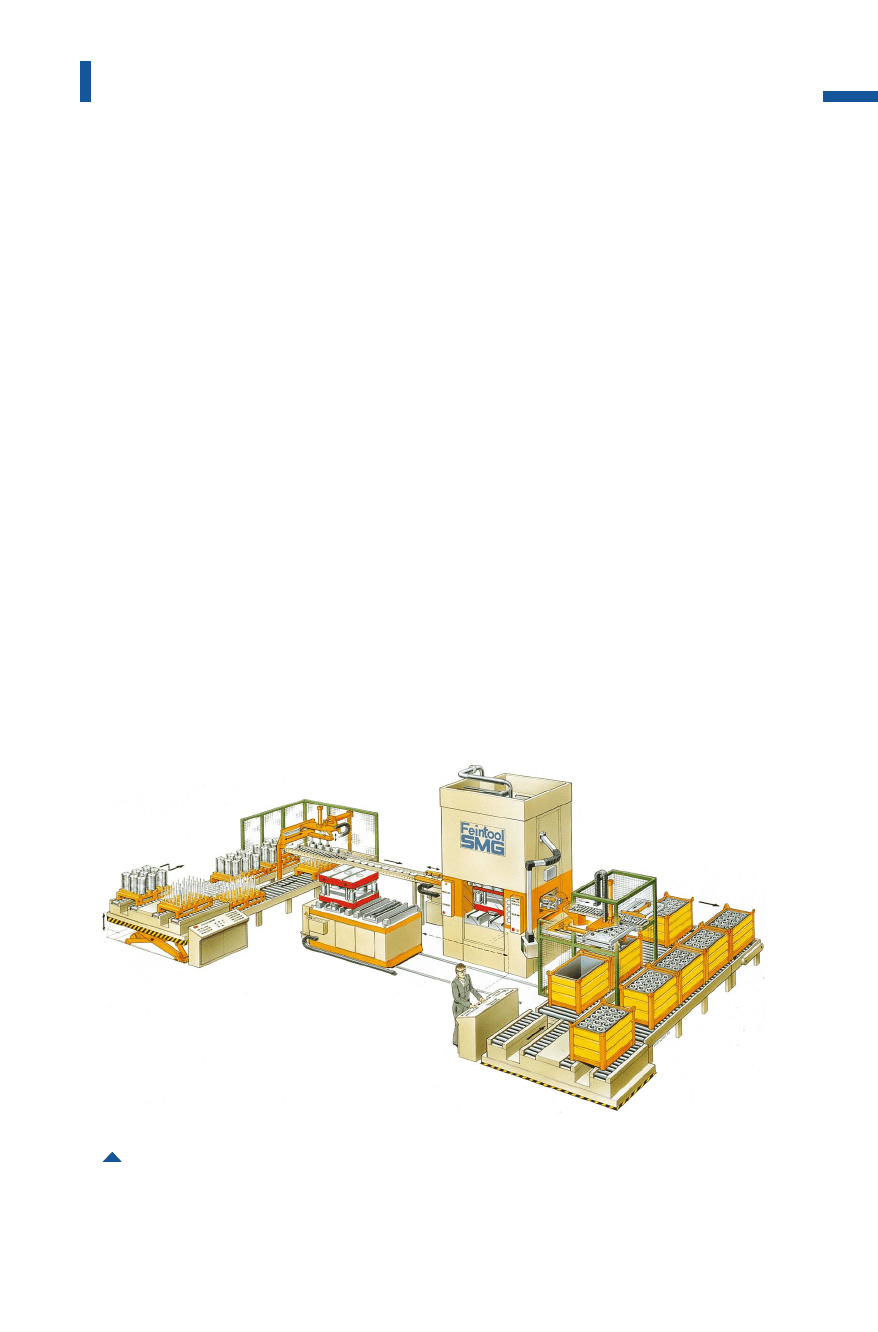
pallets reach the stacking feeder. An accumulating roller conveyor trans-
ports the pre-perforated blanks to the indexed press transfer unit which
transports them through three die stations. On the outfeed side of the
press, the finished synchronous tapered plates are fed via a buffer con-
veyor towards the stacking unit and the scrap is disposed of separately.
The loaded pallets then travel via an accumulating roller conveyor
towards the height-adjustable removal point.
Outside the press, the dies are prepared on a die change cart (cf.
Fig. 3.4.2).The three individual die modules are mounted on a common
die change plate. This system permits automatic die change to be com-
pleted in a matter of minutes.
365
Fine blanking
Fig. 4.7.31 Overall line for the manufacture of synchronous tapered cups with a 14,000 kN
CNC controlled fine blanking press
Metal Forming Handbook / Schuler (c) Springer-Verlag Berlin Heidelberg 1998

4Sheet metal forming and blanking
4.8Bending
4.8.1Bending process
Classification of bending processes
Bending by forming as a production process is subdivided according to
DIN 8586 into two groups: bending by forming using linear and rotat-
ing die motions (cf. Fig. 2.1.3).Sections 4.8.2 and 4.8.3 deal with bend-
ing using rotary die motion, i.e. roll forming and roll straightening.
These fall under the category of roll bending.
Bending radius and bending angle
Bending dies should be designed so as to avoid sharp bent edges. The
inside bending radius r
i
[mm] depends on the sheet metal thickness
s [mm] and should be selected to be as large as possible, because sharp
bent edges may lead to material failure. On principle, the bending
radius should assume the values recommended by DIN 6935, i.e. they
should be selected from the following series (preferably using the values
in bold type):
11,2 1,62 2,53 45 68 1012 1620 2528 3236 4045
5063 80100 etc.
When bending sheet metal, particular attention should also be paid to
the rolling direction. The most suitable direction for bending is trans-
verse to the direction of rolling. If the bending axis is positioned paral-
lel to the rolling direction of the sheet metal, r
imin
must be selected
higher than when bending at right angles to the direction of rolling.
Metal Forming Handbook / Schuler (c) Springer-Verlag Berlin Heidelberg 1998
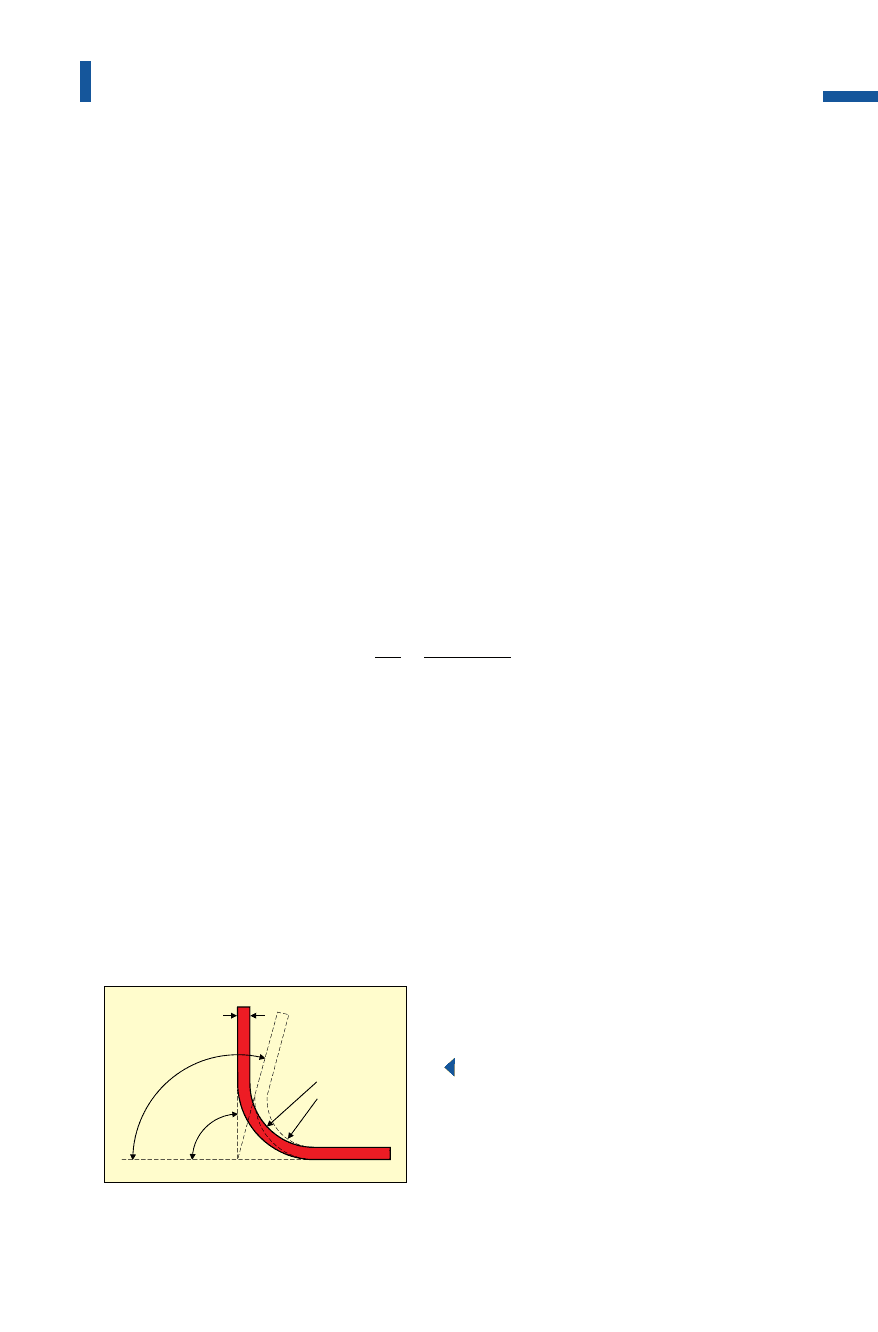
Table 4.8.1 gives the smallest admissible bending radii for bending
angle aup to a maximum of 120°. For bending angles a> 120°, the next
highest value applies: When bending Q
St
42-2 sheet steel materials with
a thickness s = 6 mm at right angles to the rolling direction, for exam-
ple, the smallest admissible bending radius r = 10 mm for a#120°and
r = 12 mm for a> 120°.
Springback
When designing a bending die, it is necessary to consider springback that
occurs after unloading. Springback characteristics differ depending on
the material type. Springback occurs with all types of forming by bend-
ing, when bending in presses, folding, roll forming and roll bending.
As a result of springback, the bending die angle adoes not corre-
spond precisely to the angle desired at the workpiece a
2
(Fig. 4.8.1). The
angle ratio is the so-called springback factor k
R
, which depends on the
material characteristics and the ratio between the bending radius and
sheet metal thickness (r/s):
With a
1
: angle at the die (required bending angle) [°],
a
2
: desired angle at the workpiece (after springback) [°],
s: sheet metal thickness [mm],
r
i1
: inside radius at the die [mm],
r
i2
: inside radius at the workpiece [mm].
The springback factor k
R
for various materials is given in Table 4.8.2.
367
Bending
s
r
i2
a
1
r
i1
a
2
Fig. 4.8.1
Elastic recovery after bending:
s sheet metal thickness, a
1
required
bending angle, a
2
desired angle,
r
i1
inside radius of die, r
i2
inside
radius of workpiece
k
rs
rs
R
i
i
==
+⋅
+⋅
[]
α
α
2
1
1
2
05
05
.
.
–,
Metal Forming Handbook / Schuler (c) Springer-Verlag Berlin Heidelberg 1998
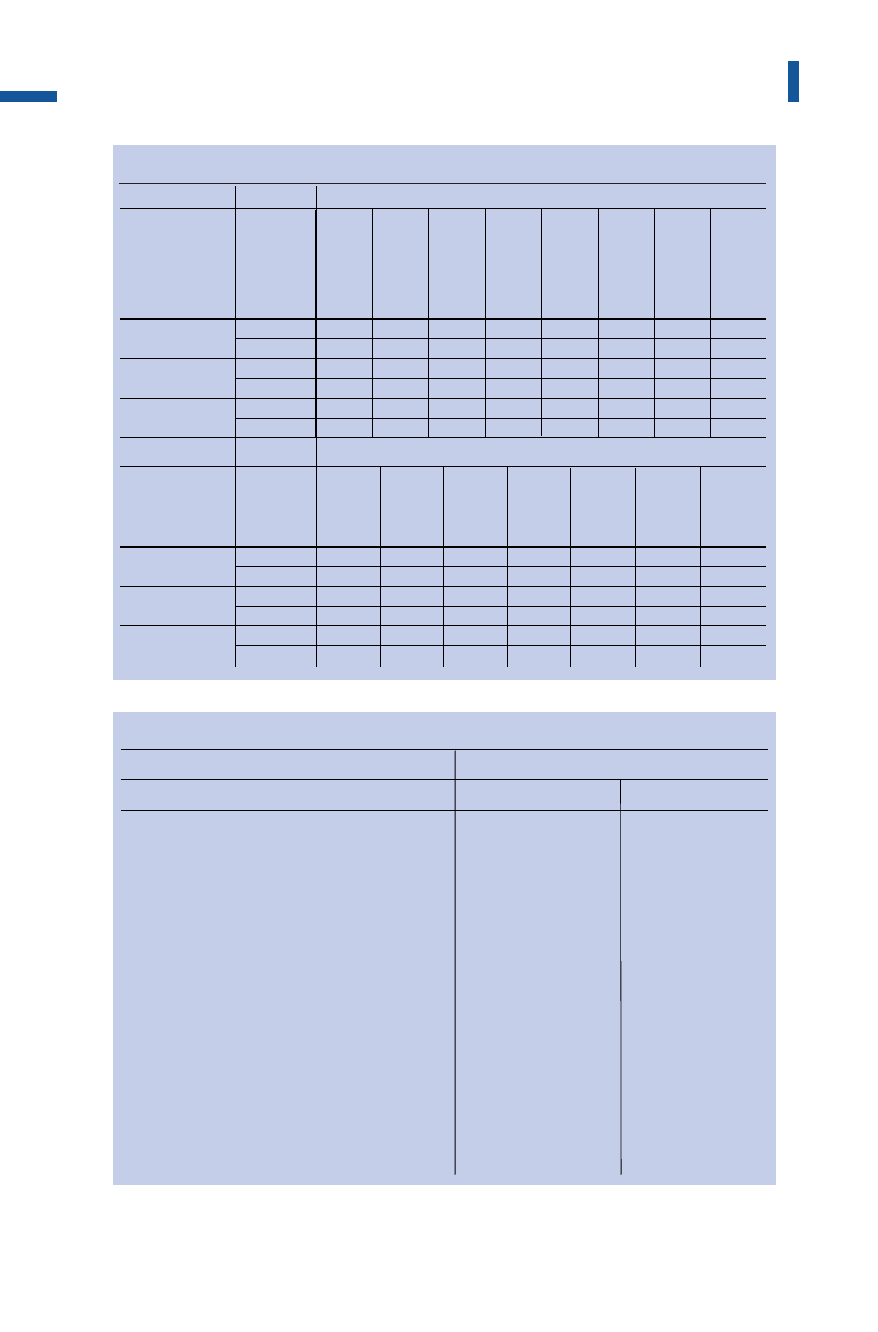
368
Sheet metal forming and blanking
Table 4.8.1: Minimum bending radius r
i min
for bending angles
a
under 120°
Bending
direction
compared to
roller
direction of
sheet
1
> 1
to 1,5
> 2,5
to 3
> 3 to 4 > 4 to 5 > 5 to 6 > 6 to 7
to 390
transverse 1 1.6 2.5 3 5 6 8
longitudinal 1 1.6 2.5 3 6 8 10
over 390
transverse 1.2 2 3 4 5 8 10
to 490
longitudinal 1.2 2 3 4 6 10 12
over 400
transverse 1.6 2.5 4 5 6 8 10
to 640
longitudinal 1.6 2.5 4 5 8 10 12
10
12
12
16
12
16
> 7 to 8 > 8 to 10
> 10
to
12
> 12 to 14 > 14 to 16 > 16 to 18 >18 to 20
to 390
transverse 12 16 20 25 28 36 40
longitudinal 16 20 25 28 32 40 45
over 390
transverse 16 20 25 28 32 40 45
to 490
longitudinal 20 25 32 36 40 45 50
over 400
transverse 16 20 25 32 36 45 50
to 640
longitudinal 20 25 32 36 40 50 63
Smallest admissible bending radius r
i min
for sheet metal thickness s [mm]
Smallest admissible bending radius r
i min
for sheet metal thickness s [mm]
> 1,5
to 2,5
Steel sorts with a
minimum tensile
strength [N/mm
2
]
Steel sorts with a
minimum tensile
strength [N/mm
2
]
Bending direc-
tion compared
to roller direc-
tion of sheet
Table 4.8.2: Springback factor k
R
Material
Springback factor k
R
St 0-24, St 1-24 0.99
St 2-24, St 12 0.99
St 3-24, St 13 0.985
St 4-24, St 14 0.985
stainless austenitic steels 0.96
high temperature ferritic steels 0.99
high temperature austenitic steels 0.982
nickel w 0.99
Al 99 5 F 7 0.99
Al Mg 1 F 13 0.98
Al Mg Mn F 18 0.985
Al Cu Mg 2 F 43 0.91
Al Zn Mg Cu 1.5 F 49 0.935
r
i2
/s = 1
0.97
0.97
0.97
0.96
0.92
0.97
0.955
0.96
0.98
0.90
0.935
0.65
0.85
r
i2
/s = 10
Metal Forming Handbook / Schuler (c) Springer-Verlag Berlin Heidelberg 1998
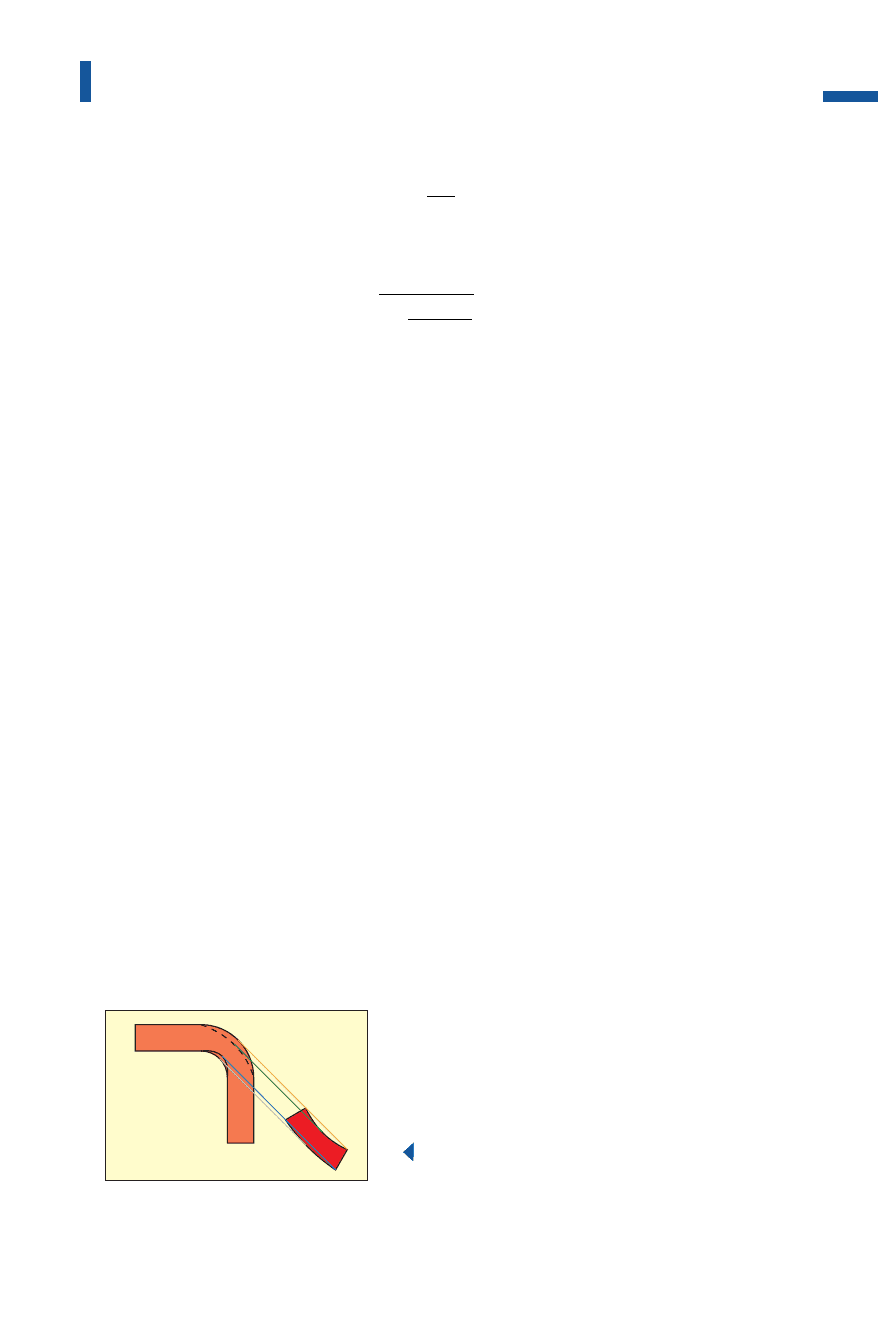
Accordingly, the necessary angle on the die is
The required inside radius at the die can thus be calculated as
with tensile strength R
m
[N/mm
2
] and elasticity module E [N/mm
2
].
Bending causes residual stresses in the workpiece. The smaller the
bending radius relative to the sheet metal thickness, the greater these
stresses are. When working with materials which are sensitive to stress-
corrosion, workpiece failure is therefore possible within a relatively short
period of time after forming. Coining following the bending process
helps to reduce residual stresses. When a subsequent heat treatment is
used to reduce residual stresses in the workpiece, it is important to
remember that heat treatment alters the workpiece radii and the angles.
Unwanted deformation during bending operations
If a sheet metal strip has a rectangular cross section, the sides of the rec-
tangle are determined by the coil width and the material thickness. In
the case of thick coil stock and sharp bends, i.e. small inside curvature
radius, this rectangle assumes a trapezoidal shape (Fig.4.8.2).
If several operations are executed on a single workpiece, i.e. several
folding processes are carried out simultaneously, steps must be taken to
ensure that sufficient material flow is available to replace the material
displaced during the forming process. Otherwise, under certain circum-
stances, it is possible that significant weakening or fracturing takes place
at the workpiece corners. In addition, the force required to achieve the
final shape increases.
369
Bending
r
r
rR
sE
mm
i
i
im
1
2
2
1
=
+
⋅
⋅
[]
Fig. 4.8.2
Deformation of the cross section during bending
α
α
1
2
=°
[]
k
R
Metal Forming Handbook / Schuler (c) Springer-Verlag Berlin Heidelberg 1998
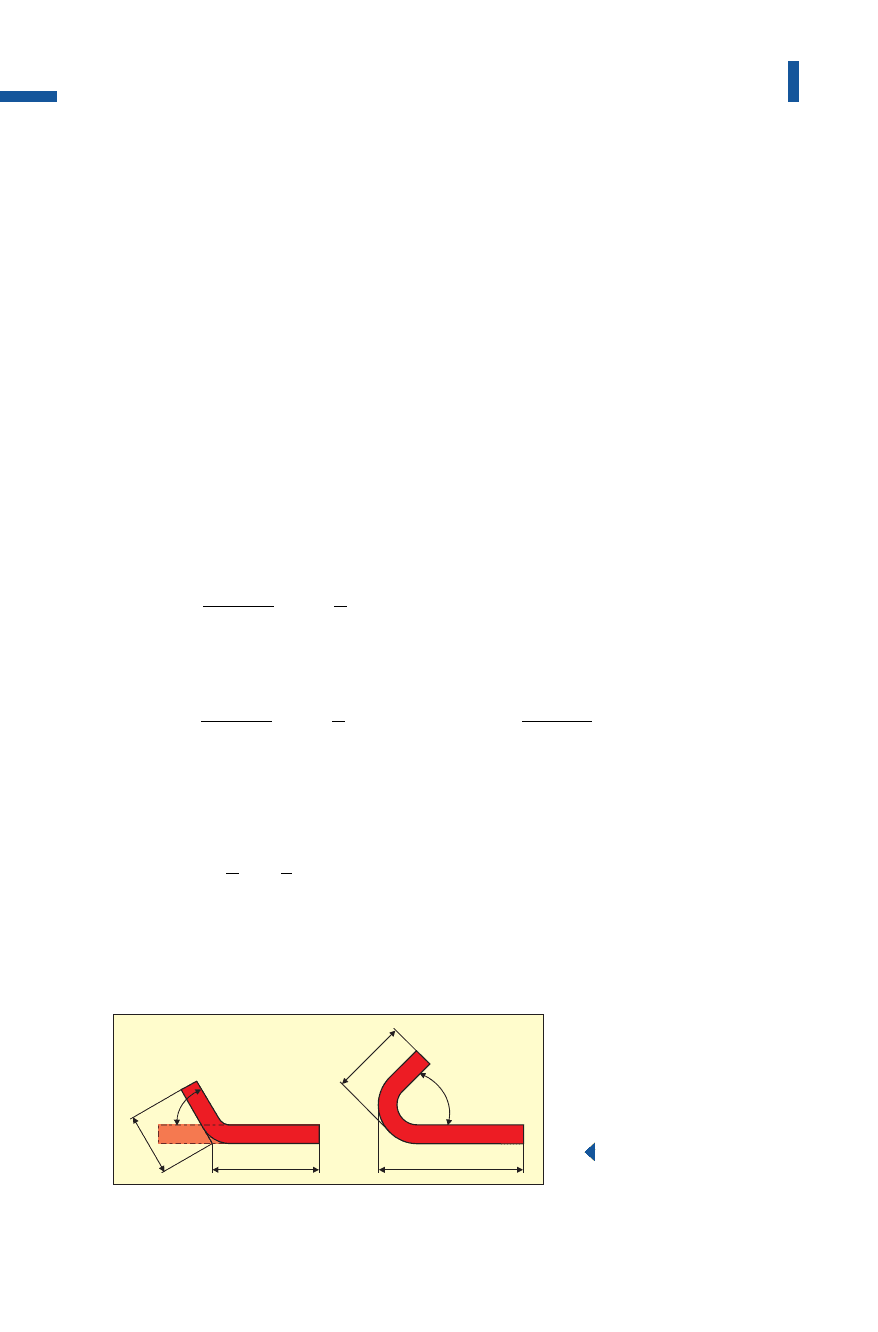
Determining the blank length for bent workpieces
The blank length of the part to be bent is not equal to the fiber length
located at the center of the cross section after bending. The extended
length of bent components 1 [mm] is calculated as
whereby a [mm] and b [mm] stand for the lengths of the two bent legs,
and v [mm] is a compensation factor which can be either positive or
negative (Fig.4.8.3).
It should be noted that ais the bending and bthe opening angle of
the bent part. Values for v are contained in DIN 6935 or can be calcu-
lated for every required angle:
– for b= 0°to 90°
– for b> 90°to 165°
with correction factor k [–]:
The calculated extended length dimensions should be rounded up to
the next higher full millimeter.
370
Sheet metal forming and blanking
– for/s5and
– f r/st5
kr
k
r
s
or o
=>
=+⋅
1
065
1
2
. log
b
α
a
β
b
a
Fig. 4.8.3
Geometry of bent legs
l a bv oropeningangles o nd
l ab oropeningangles o
=++
[]
°°
=+
[]
>° °
mm
mm
f 0t165a
f 165t 180
vr
s
krsmm
R
=⋅
°
°
⋅+⋅ ⋅+
()
[]
π
β180
180 2
2
–
–
vr
s
krs mm
R
=⋅
°
°
⋅+⋅ ⋅+
()
⋅
°
[]
π
ββ180
180 2
2
180
2
–
– tan
–
Metal Forming Handbook / Schuler (c) Springer-Verlag Berlin Heidelberg 1998
